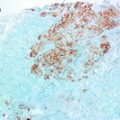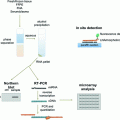Gene
Name
Location
Function
TP53
Tumor protein 53
17p13.1
Tumor suppressor
PIK3CA
phosphatidylinositol-4,5-bisphosphate 3-kinase
3q26.32
Cell growth, division and survival
AKT1
v-akt murine thymoma viral oncogene homolog 1
14q32.32
Cell growth, division and survival
GATA3
GATA binding protein 3
10p15
Transcription factors important in T cell and endothelial development
MAP3K1
mitogen-activated protein kinase kinase kinase 1
5q11.2
Protein kinase activating ERK and JNK kinase pathways
CBFB
core-binding factor, β subunit
16q22.1
Master regulator of RUNX genes
RUNX1
runt-related transcription factor 1
21q22.3
Part of core-binding factor complex
CDH1
cadherin 1 (E-cadherin)
16q22.1
Cell adhesion
Recent studies in The Cancer Genome Atlas Research Network (TCGA) shed more light on the gene deletions, mutations and amplifications commonly seen in ILC [46, 104]. Comprehensive genomic and transcriptomic analysis of breast cancers show that the major differences between ILC and IDC are mutations in TP53, PIK3CA, GATA3, MYC, MAP3K1/MAP2K4, which are more common in IDC versus PIK3CA, FOXA1, HER2 and PTEN which are more common in ILC. It is important to emphasize that the rate of HER2 gene mutation is much higher in ILC (10 % vs. <1 %), whereas HER2 gene amplification is more common in IDC (15 % vs. <5 %) [46]. The biologic significance and clinical utility of some of these alterations will need to be elucidated with further comprehensive molecular studies.
There is little known about the hereditary genetics of lobular cancer. Current evidence suggests that there is a significant overlap between genetic predisposition to IDC and ILC. However, newer studies have identified novel nucleotide polymorphisms at locus 7q34 conferring a predisposition that is specific to lobular breast cancer [105].
Molecular characterization of lobular carcinomas in the literature is relatively limited. With the advent of more advanced and readily available technologies additional molecular findings will likely emerge.
Key Points
Lobular breast carcinoma (ILC) is the second most common type of breast carcinoma.
The incidence of lobular carcinoma is rising that is due to better diagnosis and use of postmenopausal hormone therapy.
Morphologically, ILC comprises of small, dyshesive and relatively uniform cells that insidiously infiltrate the breast stroma in a single-file pattern without significant stromal reaction.
There are different subtype of ILC, with classical and pleomorphic subtypes are two most prevalent.
Loss of E-cadherin is the characteristic molecular feature of the ILC.
Underlying alteration in CDH1 gene in the form of mutation or splicing or loss of heterozygosity is seen in almost all of the ILC.
Most ILC, particularly the classical subtype, belong to luminal A molecular type of breast carcinomas.
Although there are several other chromosomal abnormalities in ILC, loss of chromosome 16q and gain of chromosomes 1q and 16p are most common changes.
Apart from changes in CDH1 gene, alterations in TP53, PIK3CA and GATA3 are also commonly seen in ILC.
References
1.
Foote FW, Stewart FW. Lobular carcinoma in situ: a rare form of mammary cancer. Am J Pathol. 1941;17(4):491–6.PubMedCentralPubMed
2.
Haagensen CD, et al. Lobular neoplasia (so-called lobular carcinoma in situ) of the breast. Cancer. 1978;42(2):737–69.PubMed
3.
Wheeler JE, et al. Lobular carcinoma in situ of the breast: long-term followup. Cancer. 1974;34(3):554–63.PubMed
4.
Andersen JA. Lobular carcinoma in situ: a long-term follow-up in 52 cases. Acta Pathol Microbiol Scand A. 1974;82(4):519–33.PubMed
5.
Brogi E, Murray MP, Corben AD. Lobular carcinoma, not only a classic. Breast J. 2010;16(Suppl 1):S10–4.PubMed
6.
Mastracci TL, et al. E-cadherin alterations in atypical lobular hyperplasia and lobular carcinoma in situ of the breast. Mod Pathol. 2005;18(6):741–51.PubMed
7.
De Leeuw WJ, et al. Simultaneous loss of E-cadherin and catenins in invasive lobular breast cancer and lobular carcinoma in situ. J Pathol. 1997;183(4):404–11.PubMed
8.
Vos CB, et al. E-cadherin inactivation in lobular carcinoma in situ of the breast: an early event in tumorigenesis. Br J Cancer. 1997;76(9):1131–3.PubMedCentralPubMed
9.
Arpino G, Laucirica R, Elledge RM. Premalignant and in situ breast disease: biology and clinical implications. Ann Intern Med. 2005;143(6):446–57.PubMed
10.
Rakha EA, Ellis IO. Lobular breast carcinoma and its variants. Semin Diagn Pathol. 2010;27(1):49–61.PubMed
11.
Simpson PT, et al. The diagnosis and management of pre-invasive breast disease: pathology of atypical lobular hyperplasia and lobular carcinoma in situ. Breast Cancer Res. 2003;5(5):258–62.PubMedCentralPubMed
12.
Lakhani SRE, Simpson PT. Invasive lobular carcinoma. In: Lakhani SEI, Schnitt SJ, Tan P-H, van de Vijver MJ, editors. WHO classification of tumors of the breast. Lyon: IARC; 2012.
13.
Daling JR, et al. Relation of regimens of combined hormone replacement therapy to lobular, ductal, and other histologic types of breast carcinoma. Cancer. 2002;95(12):2455–64.PubMed
14.
Chen CL, et al. Hormone replacement therapy in relation to breast cancer. JAMA. 2002;287(6):734–41.PubMed
15.
Shetty MR. Infiltrating lobular carcinoma: is it different from infiltrating duct carcinoma? Cancer. 1994;74(3):986–7.PubMed
16.
Silverstein MJ, et al. Infiltrating lobular carcinoma: is it different from infiltrating duct carcinoma? Cancer. 1994;73(6):1673–7.PubMed
17.
Wheeler JE, Enterline HT. Lobular carcinoma of the breast in situ and infiltrating. Pathol Annu. 1976;11:161–88.PubMed
18.
Martinez V, Azzopardi JG. Invasive lobular carcinoma of the breast: incidence and variants. Histopathology. 1979;3(6):467–88.PubMed
19.
Fechner RE. Histologic variants of infiltrating lobular carcinoma of the breast. Hum Pathol. 1975;6(3):373–8.PubMed
20.
Shousha S, et al. Alveolar variant of invasive lobular carcinoma of the breast: a tumor rich in estrogen receptors. Am J Clin Pathol. 1986;85(1):1–5.PubMed
21.
Van Bogaert LJ, Maldague P. Infiltrating lobular carcinoma of the female breast: deviations from the usual histopathologic appearance. Cancer. 1980;45(5):979–84.PubMed
22.
Bentz JS, Yassa N, Clayton F. Pleomorphic lobular carcinoma of the breast: clinicopathologic features of 12 cases. Mod Pathol. 1998;11(9):814–22.PubMed
23.
Weidner N, Semple JP. Pleomorphic variant of invasive lobular carcinoma of the breast. Hum Pathol. 1992;23(10):1167–71.PubMed
24.
Eusebi V, Magalhaes F, Azzopardi JG. Pleomorphic lobular carcinoma of the breast: an aggressive tumor showing apocrine differentiation. Hum Pathol. 1992;23(6):655–62.PubMed
25.
Silver SA, Tavassoli FA. Pleomorphic carcinoma of the breast: clinicopathological analysis of 26 cases of an unusual high-grade phenotype of ductal carcinoma. Histopathology. 2000;36(6):505–14.PubMed
26.
Middleton LP, et al. Pleomorphic lobular carcinoma: morphology, immunohistochemistry, and molecular analysis. Am J Surg Pathol. 2000;24(12):1650–6.PubMed
27.
Gamallo C, et al. Correlation of E-cadherin expression with differentiation grade and histological type in breast carcinoma. Am J Pathol. 1993;142(4):987–93.PubMedCentralPubMed
28.
Simpson PT, et al. Molecular profiling pleomorphic lobular carcinomas of the breast: evidence for a common molecular genetic pathway with classic lobular carcinomas. J Pathol. 2008;215(3):231–44.PubMed
Stay updated, free articles. Join our Telegram channel

Full access? Get Clinical Tree





